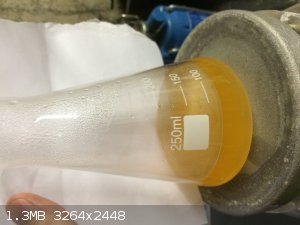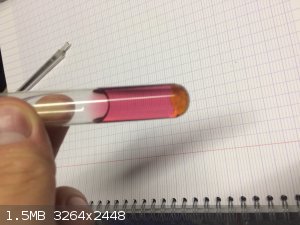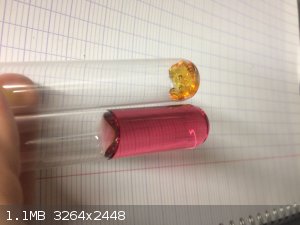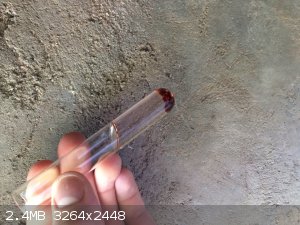Vanry
Harmless

Posts: 36
Registered: 13-12-2017
Member Is Offline
Mood: covalent
|
|
iodine-silica gel bond
After an extraction of solid iodine, I SMARTLY decided to store it over 250g of silica-gel. why silica-gel, why so much ? dunno.
Guess what ? my silica gel turned deep purple (but it doesn't smoke on the water  ) )
Now I'm guessing how to safely separate this mess. I have no knowing of an iodine based mortal poison gas, but hey, can't know everything.
Is it safe to simply heat the bottom of the flask containing the stuff and put a RBF full of cold water on top to crystalise iodine vapour ?
Do you think this will work ?
I may add pictures later for those interrested.
thanks for reading 
|
|
|
CobaltChloride
Hazard to Others
  
Posts: 239
Registered: 3-3-2018
Location: Romania
Member Is Offline
|
|
I don't think the iodine (which is creating the purple color) would cleanly separate from the silica gel beads if you just heat them. It would be
better just to drop the silica gel in a beaker of sodium thiosulfate solution (can be bought at some pharmacies as a treatment for skin disease). This
way the iodine which is giving them the purple color would be dissolved as sodium iodide. If you really want to extract the iodine from this solution
(albeit you wouldn't get much), you could just acidify it with vinegar (do this outside as SO2 could be generated) and add an oxidizing agent such as
hydrogen peroxide and then filter the iodine precipitate.
[Edited on 4-7-2018 by CobaltChloride]
[Edited on 4-7-2018 by CobaltChloride]
|
|
|
Vanry
Harmless

Posts: 36
Registered: 13-12-2017
Member Is Offline
Mood: covalent
|
|
hum. It's the same method that I used to extract it from tincture of iodine, acidify + peroxyde. But won't my silica gel dissolve in an aqueous
solution ?
And, won't hydrogen peroxyde on sodium thiosulfate react to produce sodium trithionate, wich will just increase the mess-level of this ?
If there is no risk heating it I might give it a go before trying other things.
anyway, thank for the tips 
|
|
|
symboom
International Hazard
    
Posts: 1143
Registered: 11-11-2010
Location: Wrongplanet
Member Is Offline
Mood: Doing science while it is still legal since 2010
|
|
Is the iodine really absorbed on the silica if so thats a way to store iodine and bromine which are notorous for escaping their container i have had
bromine leak out so many times luckly sodium hydroxide absorbs and reacts with halogens well to dispose of them. After using silica to make solidified
sulfuric acid i was wondering how to make many other chemicals easier and safer to work with without sacrificing product purity
Silica is quite inert to many reactions exceptions are lithium metal made silicon by lithium thermite havnt tried with others
Silica reacts with bases too if only there is a way to make compounds calcinated i think that is the term for inactivating a oxide material to make it
less reactive by heat.
http://www.sciencemadness.org/talk/viewthread.php?tid=71977#...
The Sorption of Bromine and Iodine by Silica Gel - The Journal of Physical ...damn need link
Heres a link dont have a picture
It just looks like wet oily silica gel but reacts nicely
Yes add pictures i would like to see what it looks like
I didnt think halogens can be absorbed on silica
Heating releases the compound.
[Edited on 5-7-2018 by symboom]
[Edited on 5-7-2018 by symboom]
|
|
|
unionised
International Hazard
    
Posts: 5135
Registered: 1-11-2003
Location: UK
Member Is Offline
Mood: No Mood
|
|
I strongly suspect that you could steam distil the iodine out of the silica gel.
|
|
|
Sulaiman
International Hazard
    
Posts: 3779
Registered: 8-2-2015
Member Is Offline
|
|
Iodine vapour sublimes onto glass so I'd expect it to behave similarly with silica,
heating should vaporise the iodine,
but I expect that the speed of diffusion of the iodine vapour through the bulk silica will be the limiting factor.
... maybe introduce hot dry air at the bottom of the silica gel ?
slowly, not an air blast 
EDIT: and the voids in the bulk silica would make heat transfer to the centre of the bulk also very slow.
..............................................
Do you have a guesstimate of how much iodine is in the 250g of silica gel ?
P.S. for the condenser (flask) do not use water so cold that it causes atmospheric moisture to condense
- or you will get wet/damp iodine.
(for my first attempt I 'cleverly' used ice to cool the condensing flask - not so clever )
Even boiling water temperature will condense iodine vapour.
... and water's latent heat of vaporisation 'absorbs' lots of heat,
... potentially allowing extended operating time without the need for ice.
but lower temperature is of course quicker.
P.P.S. If you decide to 'rescue' the silica gel by evaporating off the iodine,
remember that the beautiful violet cloud is choking/lethal/oxidising/corrosive/staining......
(due to iodine being a solid at RT it is easy for me to sometimes forget that it is - a halogen 
increasingly, it is easy for me to sometimes forget almost anything 
- luckily I keep a Lab Book 
(and very soon an index to my Lab Notes ... really, soon, one day, maybe ... it's on the list, somewhere)
[Edited on 5-7-2018 by Sulaiman]
[Edited on 5-7-2018 by Sulaiman]
|
|
|
symboom
International Hazard
    
Posts: 1143
Registered: 11-11-2010
Location: Wrongplanet
Member Is Offline
Mood: Doing science while it is still legal since 2010
|
|
maybe introduce hot dry air at the bottom of the silica gel ?
slowly, not an air blast
Makes me think of fluidized solid by air
The heating to separate the solids
I was thinking of just forming the triiodide salt would separate the silica from the iodine
Iodine combining with iodide to form triiodide
The process is analogous to the reaction of S8 with sodium sulfide, except that the higher polyiodides have branched structures
Polyiodides is what they are called
polyiodides can be made by addition of stoichiometric amounts of I2 to solutions containing I− and I−
3, with the presence of large counter-cations to stabilize them. For example, KI3·H2O can be crystallized from a saturated solution of KI when a
stoichiometric amount of I2 is added and cooled
[Edited on 5-7-2018 by symboom]
|
|
|
Sulaiman
International Hazard
    
Posts: 3779
Registered: 8-2-2015
Member Is Offline
|
|
Flush with ammonia,
evaporate to dryness,
.IF discharged from hospital
..THEN refine the iodine deposits from the the dried blood and shrapnel
...ELSE it does not matter
(caution: this procedure could introduce some calcium phosphate as a contaminant)
[Edited on 5-7-2018 by Sulaiman]
|
|
|
Vanry
Harmless

Posts: 36
Registered: 13-12-2017
Member Is Offline
Mood: covalent
|
|
Quote: Originally posted by Sulaiman  | Flush with ammonia,
evaporate to dryness,
if discharged from hospital refine the iodine deposits from the the dried blood and shrapnel ?
[Edited on 5-7-2018 by Sulaiman] |
great idea ! Gonna try it ASAP ! I wasn't aware that nitrogen triiodide could be so easily synthesize. Good security point here: store far from each
other.
back to subject, I have absolutely no clue of the iodine quantity, as I have no idea of iodine density, and little idea of a guessed volumetric
amount. Is "a lot, but under 6g" a satisfying answer ?
on the experimental side, I got an idea. I can put my Silica gel in a buchner funnel and use it reversed to blow air instead of succking. By doing
so, my container and condenser-flask would be more impervious (is "impervious" right ? I'm really not sure of this word). But it create te problem of
heating the bucher, as my hot-plate is... well... a plate. not a milimeter-molded heater for buchner.
|
|
|
Sulaiman
International Hazard
    
Posts: 3779
Registered: 8-2-2015
Member Is Offline
|
|
Some sort of air heater (e.g. hotplate, resealable tin can, two tubes for air in/out, air pump) may be enough,
the hot air removes the need for direct heating.
You could make a larger hole and and fit the Buchner directly into the top of the can ?
If no resealable can is available, buy a can of soup and use the holes for the Buchner and for the air inlet to remove the soup for consumption ?
[Edited on 5-7-2018 by Sulaiman]
|
|
|
Vanry
Harmless

Posts: 36
Registered: 13-12-2017
Member Is Offline
Mood: covalent
|
|
hum. I don't have an air pump, but I got a membrane liquid pump. Should be enough for a little cute light breeze.
why not fill the can with the body of the air tube and add oil to make a oil bath ? it would heat air well i think
|
|
|
Sulaiman
International Hazard
    
Posts: 3779
Registered: 8-2-2015
Member Is Offline
|
|
Sounds like a plan !
Go for it.
|
|
|
Morgan
International Hazard
    
Posts: 1728
Registered: 28-12-2010
Member Is Offline
Mood: No Mood
|
|
As an aside in reference to the triiodide comment, the other day I was wondering how it goes if you were to pump NH3 into a shallow dish covered with
plastic wrap or something convenient with a small amount of iodine crystals. The thought being dry ammonia gas would form the triiodide without the
"bothersome" having to wait for a wet sludge to dry when using the standard NH4OH.
So perhaps the outer layer of the iodine crystals would react and prevent or slow the inner mass from combining further or being highly sensitive and
dry, the triiodide
would snap, crackle, and pop as the ammonia combines with the iodine. It might be interesting to see whatever scenario takes place. Perchance there is
a video describing it somewhere.
[Edited on 5-7-2018 by Morgan]
|
|
|
unionised
International Hazard
    
Posts: 5135
Registered: 1-11-2003
Location: UK
Member Is Offline
Mood: No Mood
|
|
The advantage to steaming out the iodine is that silica gel has a strong affinity for water ad so the iodine will be displaced from the active sites
in the gel.
The solubility of iodine in water is fairly low so you should be able to recover it by filtration.
It's not difficult- put the silica in a distillation flask, add water to cover and then distil out the water until the colour of the iodine is gone.
On a related note, scraps of silica gel make good anti bumping granules.
|
|
|
symboom
International Hazard
    
Posts: 1143
Registered: 11-11-2010
Location: Wrongplanet
Member Is Offline
Mood: Doing science while it is still legal since 2010
|
|
How did this thread get to nitrogen triiodide
potassium triiodide gets mixed up on the internet as some think it is the same because of reading triiodide.
was refering to Lugol's iodine contains potassium iodide and a stoichiometric amount of elemental iodine
Forms potassium triiodide
The triiodide i was talking about was the combination of potassium iodide and iodine a easy way to make iodine souble
and leach it out from the silica gel but it seems unionized figured out a better way
[Edited on 6-7-2018 by symboom]
|
|
|
Vanry
Harmless

Posts: 36
Registered: 13-12-2017
Member Is Offline
Mood: covalent
|
|
Quote: Originally posted by symboom  | How did this thread get to nitrogen triiodide
The triiodide i was talking about was the combination of potassium iodide and iodine a easy way to make iodine souble
and leach it out from the silica gel but it seems unionized figured out a better way
[Edited on 6-7-2018 by symboom] |
I wasn't answering you'r post, no link between youre triiodide and the explosive one  And I'm not sure to understand. As a result you'll get a solution of I2/I3 and KI ? and how to separate all of this from the solution.
just evoparating the water ? And I'm not sure to understand. As a result you'll get a solution of I2/I3 and KI ? and how to separate all of this from the solution.
just evoparating the water ?
I'm gonna try the hot air approach first, and if it didn't work, try steaming the stuff. In fact, just adding water might be enought, if water
displace iodine from silica gel at RT, iodine will spontaneously cristalyse and a simple filtration will do the job.
and to end this, a promise made is a debt unpaid, got the pics:
https://image.noelshack.com/fichiers/2018/27/5/1530874654-im...
https://image.noelshack.com/fichiers/2018/27/5/1530874655-im...
[Edited on 6-7-2018 by Vanry]
|
|
|
Sulaiman
International Hazard
    
Posts: 3779
Registered: 8-2-2015
Member Is Offline
|
|
OR
I doubt that SiO2 would interfere with most reactions where iodine is required,
and you seem to have discovered a method of storing dry iodine without it escaping the container.
So you could just leave it as-is until required for an experiment requiring iodine ?
To satisfy my curiosity, could you get a larger piece and break/smash it to see how deeply the iodine has penetrated the silica ?
(A quick google suggests that silica gel pore size is around 60 Angstrom (6nm) ... easily large enough for iodine to diffuse throughout the mass)
So it could be that to facilitate the recovery of the iodine you should pulverise your silica gel.
P.S. with steam or water my concern is that you could end up with a worse mess than you started with.
Try heat, heated air, water, and steam at test tube level first ?
P.P.S. the side-tracking to nitrogen triiodide was my fault 
It was my favourite as a youth and it keeps calling me to be friends and play together again ....
Afterthought:
In your position I imagine that I would want to see a nice sample of shiny dry iodine crystals as a reward for my efforts,
but as an observer I say
"keep as-is in a better container until you decide how to refine or use the iodine, as it seems to be in a stable, usable, and storable form"
this way you can self-justify doing the experiment again ... with more pre-planning 
OTOH cleaning up mistakes teaches more than a well-followed procedure 
[Edited on 6-7-2018 by Sulaiman]
|
|
|
symboom
International Hazard
    
Posts: 1143
Registered: 11-11-2010
Location: Wrongplanet
Member Is Offline
Mood: Doing science while it is still legal since 2010
|
|
i conclude silica gel can absorb
Nitrogen dioxide
Sulfuric acid
Iodine
bromine
chlorine
Any other uses
Just wont absorb hydrogen
And organic compounds that what aerogel grafite is for
And apparently
Alkali metals absorbed into silica gel yield three stages of unique loose black powders (M-SG) that are strong reducing agents. All react nearly
quantitatively with water to form hydrogen. Liquid Na-K alloys form air-sensitive powders at room temperature that can be converted at 150 degrees C
to a form that is sensitive to moisture but not to dry air. Slowly heating sodium and silica gel to 400 degrees C yields a third type that can be
handled in ambient air with only slow degradation by atmospheric moisture. These materials eliminate many hazards associated with pure alkali metals
and provide easily handled reducing agents and hydrogen sources. They could be used in continuous-flow reactors to reduce and protonate aromatics,
dechlorinate alkyl and aryl halides, and desulfurize various compounds.
[Edited on 7-7-2018 by symboom]
|
|
|
12thealchemist
Hazard to Others
  
Posts: 181
Registered: 1-1-2014
Location: The Isle of Albion
Member Is Offline
Mood: Rare and Earthy
|
|
Have I missed something here, or could you use a non-polar solvent like hexane or toluene or chloroform to dissolve the iodine out of the silica gel?
Then distil/evaporate the solvent off. I am aware of the possibility to lose a little iodine, but surely it should be possible to do without too much
loss?
|
|
|
Vanry
Harmless

Posts: 36
Registered: 13-12-2017
Member Is Offline
Mood: covalent
|
|
ok, some test have been done today !
first, a crash test to know if there was a iodine contamination deep to the core.
(sorry i don't have picture for this I can and will add them later)
I hammered separately 2 very dark cristals and one that was a bit less dark. A mix of yellow and dark purple particules came out, no special
differences between the very dark ones and the lighter one, except the absence of very dark bits in the 3rd one, wich is normal.
May be a good idea to sand one cristal halfway to see if there is a color gradient. But I already sanded two of my fingers recently, so you'll
understand that I don't plan to approach this tool for the few months to come.
Anyway, after this i decided to test the effect of heat. I took a pinch of cristals and put them in an erlen:

after 5m of little heating it started releasing little purple vapour. but no iodine never cristalize. I think the silica gel recaptured it too fast.

I grinded some in a mortar, (if somebody do this again, put a mask. silica gel make an insane lot of dust, and a dessicant/halogenated compound is not
something youre lungs will love. I wasn't ready and I still cough a little)

then I heated this dust and the purple cloud appeared almost instantanely.

I didn't do it long enought to see if iodine cristals would form but I think it would be possible to recristalize it. Since it is a better storage,
and I already got iodine crystal to satisfy my eyes, there is no use in proceding further.
For the sake of science I put some in water, and it just get messier. silica gel/iodine dissolved without anything cristalizing, or not even a purple
color. just a yellowish solution. heating just finished dissolving silica gel.


well, I may keep doing some things on this, but it is already pretty usefull. I may use it to activate Mg for some grignard, I've read somewhere that
we can activate Mg with iodine vapour before using it. (maybe not on the first try, as this would be my first grignard, and I will probably mess it
up, no need to add difficulty)
anyway, keep posting idea, I may give it a go from time to time. Right now the next try would be organic solvent, I got benzene that would do a nice
job.
edit: photos are way too big, but I have no idea to correct that xD
at least we got details.
[Edited on 7-7-2018 by Vanry]
|
|
|
unionised
International Hazard
    
Posts: 5135
Registered: 1-11-2003
Location: UK
Member Is Offline
Mood: No Mood
|
|
"edit: photos are way too big, but I have no idea to correct that "
Delete them, resize them on your computer + repost them.
|
|
|
wg48
National Hazard
   
Posts: 821
Registered: 21-11-2015
Member Is Offline
Mood: No Mood
|
|
Vanry:
If you must post huge pics make them an attachment instead of inserting them.
See one of your pics below which I have made an attachment in this post.

Borosilicate glass:
Good temperature resistance and good thermal shock resistance but finite.
For normal, standard service typically 200-230°C, for short-term (minutes) service max 400°C
Maximum thermal shock resistance is 160°C
|
|
|
Vanry
Harmless

Posts: 36
Registered: 13-12-2017
Member Is Offline
Mood: covalent
|
|
Some news from the battlefield !
The erlenmeyer containing the Silica-iodine (I'm gonna write SiI from now) mess became transparent with a light white precipitate after Two week of
air exposure. No idea of what was going on, but I still wanted to mention that.
On the other hand I tried to extracting iodine with benzene.
It worked wonderfully (pictures bellow). The Si gel became yellow as his original colour, and the benzene became purple. Only thing that made me "meh"
was a strange bubbling occuring during the dissolution of iodine. Iodine gas ? Hydrogen ? I thinked for a second to try a sparkle test for hydrogen,
but using approximately 3 neurons for 5 seconds made me realize that benzene + Fire isn't a good mix.
Now I'm figuring if distilling will work as bezene and iodine may vaporise together instead of separating (my hotplate was already used, can't test
it)
  
|
|
|